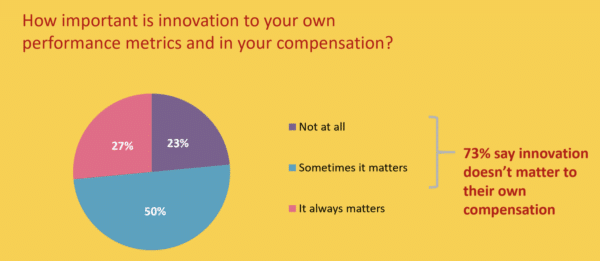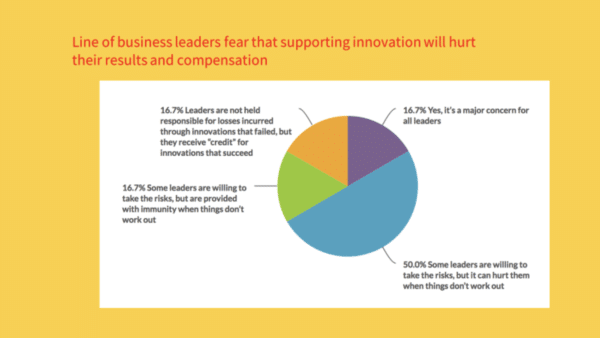Even with the best intentions, reward systems in corporate life all too often mean that most of the people you need supporting innovation work flee from it. Here are some ideas for getting a better balance.
One of the most impactful articles on the topic of reward systems was written by iconic HR expert Steve Kerr, who went on to legendary roles in talent and leadership development at GE and Goldman Sachs. It was called “On the Folly of Rewarding A while Hoping for B.” In it, he shows how clueless systems of perverse incentives all too often lead us to outcomes that are terrifically unwelcome or even dangerous. Real innovation killers.
Allocate costs wisely – or else
For instance, one client of mine created this fantastic innovation-bootcamp-in-a-box. It was beautifully designed and little expense was spared in bringing together great thinking, tools, and facilitators to run the boot camp. I was there when the organizers made a highly enthusiastic pitch to a group of business leaders to engage them in using it. The way the funding for the program would work is that corporate was going to pay all the design, facilitation and back office costs of running the workshops. All the corporate general managers had to do was pay for the travel and expenses of their people to attend (this was long before virtual became a way of life).
At lunch, during a break in the proceedings, one of the managers confided to me, “Well, that’s not going to happen in my unit.” Surprised, I asked “why not?” The way the project was going to be funded, he explained, would treat the travel expenses as a cost of doing business, that in turn would depress the margins his group would make, and that in turn, he said wryly, “would cost me a major bonus (he enumerated the amount) personally just on the expense of that event.” No way is that program ever going to get off the ground.
If you happen to work for a company owned by a private equity firm, this kind of cost-based logic runs rampant. Most of them haven’t figured out how to grow the companies they acquire for this reason.
Allocate rewards wisely – or else
The same kind of thinking applies to the other end of the spectrum, when people consider how they are going to be rewarded. I’ve seen companies literally threatened with extinction become so locked into the current business model that their leaders run them into the ground. The desperate attempt to prop up a business that is just not going to lead to the future ignores those opportunities that are small today, but promising in terms of growth. In his great book “Zone to Win, ” Geoffrey Moore has a whole table full of examples!
The Innovation Mastery Scale
One of the diagnostics I’ve developed in working with companies is what I’m calling an Innovation Mastery Scale. It measures whether basics – like rewarding innovation – are in place in your organization. It is based on an online survey that is distributed broadly across the organization, with responses from different levels, functions and geographies.
Three very telling questions with respect to rewards are:
- How difficult it would be to get small amounts of experimental capital to test a new idea out?
- How important it is to your own metrics and compensation that the organization succeeds in innovating?
- Do you agree that line of business leaders fear that supporting innovation will hurt their results and compensation?
Here’s what the results looked like from a recent survey:

In this company, 66% of funding for this purpose is completely haphazard, and people didn’t know where to go to access the funding that existed.

Similarly, 73% of the respondents (from across the organization) said that innovation doesn’t routinely matter to their own compensation.

On the third question regarding their careers, 73% of the respondents felt that it would be a career risk for managers to support or promote innovations.
Well, back to Steve Kerr’s point – if you aren’t rewarding, or are actively discouraging, innovation, why do you expect innovative results?
More innovation-friendly mechanisms
I get it – there is something to be said for holding people accountable for performance. That’s not what we’re talking about here. Instead, be honest about what you are actually rewarding for and what behavior that is inspiring.
So, how to do better? My friend, physicist and entrepreneur Safi Bahcall boils it down to an equation in his great Harvard Business Review article, “The Innovation Equation.” He suggests structural remedies. These include the extent to which compensation reflects the outcome of projects as opposed to rank within the organization; ratio of project-skill fit (how suited employees are to the tasks they’re assigned) to return on politics (the benefits accrued by networking and politicking); management span (the number of direct reports per leader); and salary step-up (the financial benefits of rising in the hierarchy). Read the article, it’s terrific!
Satya Nadella, in getting his leadership teams to be more forward-thinking, has built leading indicators for innovation into the compensation structure at Microsoft. These include (incredibly) issues such as “customer love” and “empathy.”
Other companies, such as Adobe and Netflix, have combined operating models that emphasize a great deal of autonomy combined with attractive levels of pay without singling out specific innovations for rewards.
We could stand to learn from all these examples.
Getting started
My own suggestion would be to take the following steps:
- Start with the disincentives. If you can hunt down the reward factors that are causing leaders to actively discourage innovative activities and remedy them, that is a great start.
- Next, find out what your organization’s particular innovation blockers are – usually, they aren’t financial or codified, but rather are rigid ways of working, legacy practices and frankly employees who are kind of stuck in a rut that get in the way.
- Try some experiments. There is a lot being done in the realm of agile methodology that could get you to a more innovative result without a whole lot of investment. Steve Denning’s book “The Age of Agile” is a great place to start, as is the work of Darrell Rigby on when agile is the answer (and when it isn’t).
Most Recent Posts
Explore the latest innovation insights and trends with our recent blog posts.












